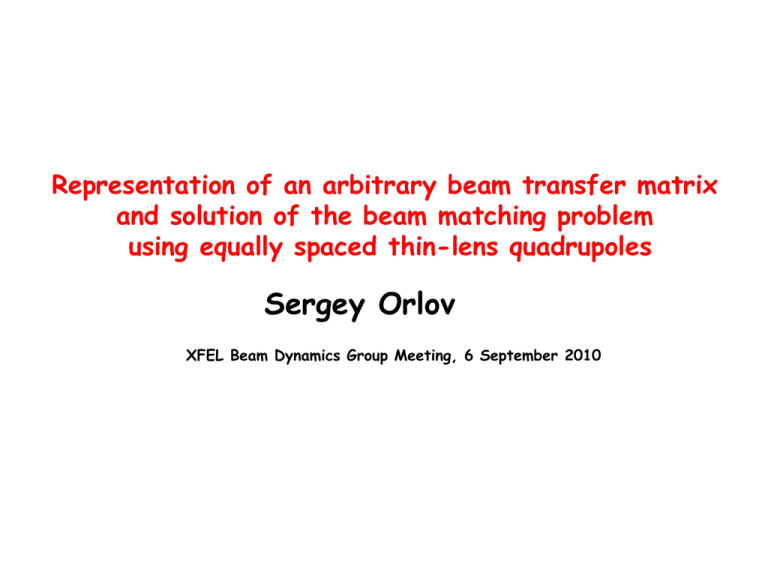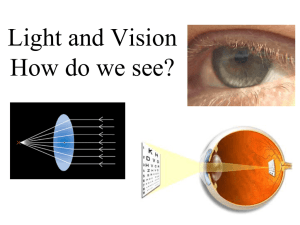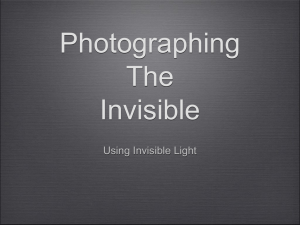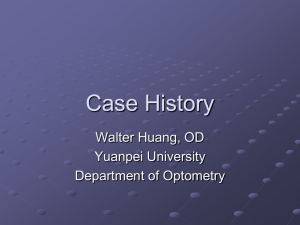Representation of an Arbitrary Beam Transfer Matrix Using
advertisement

Representation of an arbitrary beam transfer matrix and solution of the beam matching problem using equally spaced thin-lens quadrupoles Sergey Orlov XFEL Beam Dynamics Group Meeting, 6 September 2010 Acknowledgements Being a summer student I would like to thank all members of the Machine Physics Group for their hospitality, support, and enormous help with solving many organizational questions. I would like to thank the head of DESY Summer Student Program Professor Meyer for giving me the opportunity to come here and get such great experience not only from professional point of view. Last but not least, I would like to thank my supervisor V.V. Balandin for his wonderful thoughts and fantastical support in all questions that I had, for many hours of patient explanations, corrections and clarifications, as well as for guidance throughout the whole summer student program. Since invention of alternating-gradient focusing there are still several questions which don’t have strict mathematical answers yet: Is it possible to obtain an arbitrary block-diagonal 4×4 transfer matrix using only drifts and quadrupoles? If the answer to the question above is positive, could it be done with the number of quadrupoles which does not depend on input beam transfer matrix? If again the answer to the question above is positive, what is the minimum number of quadrupoles required and could we get analytical formulas for quadrupole strengths and lengths of field free spaces (drifts)? Surprisingly, the answers to these questions are not known not only for quadrupoles but also for the situation when instead of quadrupoles their thin-lens approximations are used. In this presentation we will try to answer these questions in the case when thin-lens approximation for quadrupole focusing matrices is used. Mathematical formulation of the problem of representation of an arbitrary uncoupled beam transfer matrix by drifts and quadrupole thin lenses Let M x and M y be arbitrary 2×2 matrices with unit determinant, and let D(l ) and Q (k ) be 2×2 matrices of drift space and thin lens quadrupole respectively, 1 l , Dl 0 1 1 0 . Qk k 1 The problem of representation of an arbitrary beam transfer matrix is: are there a natural number n , real numbers k1 ,, kn , and non-negative l1 ,, ln , such that the following equality holds: Q(k1 ) D(l1 ) Q(kn ) D(ln ) M x , Q(k ) D(l ) Q(k ) D(l ) M . 1 1 n n y What is actually known about this problem There are several papers, whose authors tried to find solution of this problem in the form of exact analytical formulas, with most advanced probably being the following: 1. 2. Y-Chiu Chao and John Irwin, “Solution of a three-thin-lens system with arbitrary transfer properties”, SLAC-PUB-5834, October 1992. O. Napoly, “Thin lens telescopes for final focus systems”, CERN/LEP-TH/89-69, CLIC Note 102, November 1989. For example, authors of the paper 1 give formulas for k -values and drift lengths in the case of three thin lenses and three variable field free spaces, i.e., in the case of equations: Q(k1 ) D(l1 )Q(k2 ) D(l2 )Q(k3 ) D(l3 ) M x , Q(k1 ) D(l1 )Q(k2 ) D(l2 )Q(k3 ) D(l3 ) M y . Unfortunately, the given solution contains roots and denominators, and it is clearly visible that these denominators can be equal to zero for some input matrices and, due to presence of roots, some solutions can become unphysical (complex roots). And actually, as it will be shown later by example, three drifts and three thin lenses are insufficient for representation of an arbitrary beam transfer matrix. What we have to solve After multiplying all matrices on the left-hand side of the equations Q(k1 ) D(l1 ) Q(kn ) D(ln ) M x , Q(k1 ) D(l1 ) Q(kn ) D(ln ) M y we obtain the following system of eight equations (+ 2 symplecticity conditions): f1 (k1 , l1 ,, k n , ln ) m11x 0, f (k , l ,, k , l ) m y 0, n n 22 8 1 1 where the functions f1 ,, f8 are polynomials of variables k i and we have to solve the system of non-linear polynomial equations. li , i.e., What is known about polynomial systems Let us consider first the system of linear equations (system of first order polynomial equations). For linear systems there is a complete theory, which in algorithmic way allows to answer the questions about the number of its solutions (unique solution, many solutions, solution doesn’t exist at all). This algorithmic way is called Gaussian elimination and allows to construct triangular system, which is equivalent to the original one. What is known about polynomial systems Surprisingly, for general polynomial system there exists the similar algorithm, which allows to construct the equivalent system, which is called Gröbner basis, and it is an analogy of triangular form of linear system. So, for general polynomial system one can also answer in algorithmic way about absence or existence and number of its solutions. Nowadays, the reduction of original system to its Gröbner form can be done with the help of computers using such formula manipulators as Maple or Mathematica. Unfortunately, this equivalence of original system and its Gröbner form takes place only over the field of complex numbers and appears to be not very useful for us, as far as we are interested in physical (real) solutions. Nevertheless, the use of computer assistance is not completely useless in our problem. Because the absence of complex solutions means also the absence of real solutions, computer helped us to construct examples of particular matrices, which can not be represented with certain number of thin lenses. Example of matrix which can not be represented by 3 thin lenses and 3 variable drift spaces 1 1 Mx My 1 0 This matrix can not be represented with less than 5 thin lenses and 4 variable drift spaces (in total, 9 parameters). This example was found with the help of Maple and checked once more using Mathematica program. This example clearly shows that the simple “degree-of-freedom count” not always leads to the correct answers. Equally Spaced Quadrupoles As far as the hope to give the main job to the computer failed, the only way left to get some insides into the problem is to make hand calculations. For this purpose we consider the system constructed from equally spaced thin lenses. Such systems, as we will see, have very pleasant symmetry, which significantly simplifies hand calculations. k1 k2 kn k3 l const As one see, the matrix of thin lens sandwiched between two equal drift spaces is similar to the matrix P , which depends on the single parameter only. 1 l 1 0 1 l S (l ) P(a) S 1 (l ) R 0 1 k 1 0 1 a 1 P(a) 1 0 a 2 2kl S (l ) 1 l l 2 1 l 1 l Equally Spaced Quadrupoles: Equations in new variables The equality R S (l ) P(a)S 1 (l ) allows us to reformulate the original problem R(k1 , l ) R(kn , l ) M x , R(k1 , l ) R(kn , l ) M y in the more simple form P(a1 ) P(an ) M x , P(4 a1 ) P(4 an ) M y , where the matrices on the right-hand side can be calculated with help of the formulas below: M x S 1 (l )M x S (l ), M y S 1 (l )M y S (l ). One Dimensional Case Let us consider first the one dimensional problem, when we are interested, for example, only in horizontal motion. This consideration is useful not only from methodological point of view but we will use it later for the solution of complete 2D problem. We start from consideration of three thin lenses from that physical point of view of “degree-of-freedom count”. m11 m12 . P(a1 ) P(a2 ) P(a3 ) m21 m22 Due to the simple form of the matrix P , this system can be easily solved by hand with respect to variables a i , and we obtain the following possibilities: when m22 0 , we have unique solution and when m22 0 , the solution either does not exist or is non-unique. Geometrical interpretation: 2×2 symplectic matrix depends on 3 parameters. In the space of these 3 parameters there is a plane, and on this plane there is a line. If matrix parameters are outside the plane, then solution is unique. If parameters are on the plane but outside line – solution does not exist. And if we are on the line, we have infinite number of solutions. In order to have solution for an arbitrary matrix M , we need to add one more parameter. It could be the distance l between lenses or one more thin lens. In both cases solution will be non-unique for each input matrix. Reduction 2D 1D Though 1D problem can be easily solved by hand, the complete 2D problem still remains too complicated for the hand solution. It is mainly connected with the fact that thin lens can not act in two planes independently; if it focuses beam horizontally, then it defocuses beam vertically and vice versa. Fortunately, we have found four-lens combination which has transfer matrix similar to the transfer matrix of a single thin lens but its actions can be chosen independently for both transverse planes. Let us consider four-lens block, where two lenses in the middle are set to the constant values a2 2 3 , a3 2 3 (or a2 2 3 , a3 2 3 ) By direct matrix multiplication one can show that c wx , Px ( wx ) P(a1 ) P(a2 ) P(a3 ) P(a4 ) 1/ c 0 P ( w ) P(4 a ) P(4 a ) P(4 a ) P(4 a ) wy y y 1 2 3 4 1/ d d , 0 where wx and wy are linear functions of parameters a1, a4 and c and d are some constants. Because 2×2 matrix which connects wx and wy with a1 and is non-degenerated, the values of parameters wx and wy can be chosen independently. a4 Solution of 2D problem by its reduction to the two 1D problems For solution of 1D problem we need three thin lenses plus one additional parameter for making m22 0. So if we take our three four-lens blocks, we will have three independent lenses for each plane (the fact that in these equivalent lenses we have constants c and d not equal to 1 is not essential). x y In order to satisfy conditions m22 0 and m22 0, we need one more parameter, which again could be chosen either as a distance between lenses or we may add one more lens. So we have found thin lens solution of the problem of representation of an arbitrary transfer matrix, which requires 13 thin lenses or 12 lenses with possibility to use distance between them as an additional parameter. Note that in the case of 13 lenses considered solution actually uses only 7 parameters in order to represent an arbitrary transfer matrix because 6 lenses are set to the constant strengths (in the case of 12 lenses 7 parameters depend on input matrix and other 6 – just on distance between lenses). Although the total number of lenses used in this solution is probably still not the minimal needed, we have simple explicit formulas for the lens strengths as functions of coefficients of input transfer matrix. And as concerning number of variable parameters in our system (7 parameters in the case of 13 lenses), it is the minimum possible value because we have an example of transfer matrix which can not be represented by using six lenses with fixed distance between them, namely 0 1 . M x M y 1 0 Beam Matching Problem Let us assume that we have two sets of Twiss parameters given in the two points of a beam line. The beam matching problem is the problem of finding transfer matrix A , such that the following identity holds: 2x Ax 1x Ax , y y x x . , y x 2 1 y y y Ay y Ay , x x The first question is if this problem has symplectic solution at all for arbitrary two sets of Twiss parameters. The answer is “Yes”, it is well known, and the general symplectic solution of the matching problem can be expressed in the following form: 1 A T x x 2 R ( x )Tx1 , 1 A T y 2 R ( y )Ty1 , y cos R( ) sin sin , cos 1/ T / 0 and depends on two arbitrary parameters (phase advances). Because our previous solution for an arbitrary transfer matrix certainly gives also the solution of the matching problem, our current goal is to solve matching problem with less thin lenses using freedom in choosing the phase advances. Thin lens solution of the matching problem We will use the same scheme as before and will find first the number of thin lenses required for solution of 1D problem, and then we will use our four-lens blocks for solution of 2D problem. Matching equations for 1D problem where 1a11 (1 2 )a12 2 a22 0, 2 1a11 1 2 a21 1 2 a12 1 2 a22 a12 0, aij are the coefficients of matrix A . It is not difficult to show that this problem can be solved with 2 lenses, if and only if 1 2 1 . So, as before, one more parameter for solution of 1D matching problem is still needed. Again, it could be one more lens or variable distance. Therefore, using two four-lens blocks plus one additional parameter we can get a complete solution of 2D beam matching problem (so in our solution we need 9 lenses with 4 again staying fixed). And also we have an example of Twiss parameters which can not be matched with 4 thin lenses: 1 3 0 , 0 3 1 x 1 y 1 0 . 0 1 2 x 2 y Summary It is proven that, actually, an arbitrary beam transfer matrix and the problem of matching of arbitrary Twiss parameters can be solved with finite number of thin lenses. We have found a solution for representation of transfer matrix, which uses 13 thin lenses (or 12 lenses plus variable space between them). From this 13 parameters 6 are independent from the elements of the input matrix. We also have found an example of the matrix, which can not be represented with less than 7 parameters. We have found a solution of matching problem, which uses 9 thin lenses (or 8 lenses plus variable space between them). From this 9 parameters 4 are independent from the elements of the input matrix. We also have found an example of Twiss parameters, which can not be matched with less than 5 parameters. Thank you very much for your attention!







